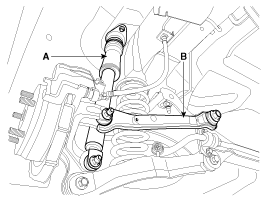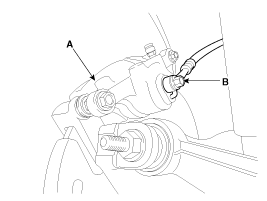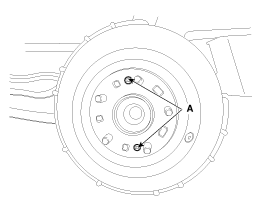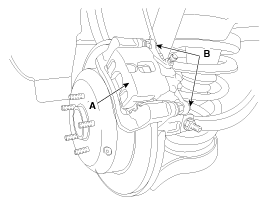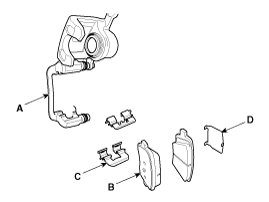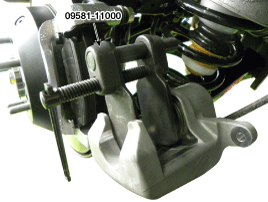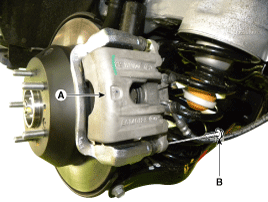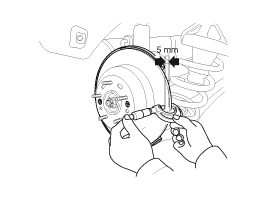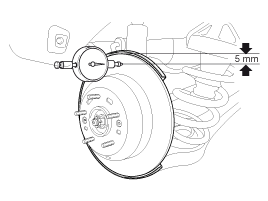 Kia Sedona: Rear Disc Brake Repair procedures
Kia Sedona: Rear Disc Brake Repair procedures
Third generation YP (2014-2026) / Kia Sedona YP Service Manual / Brake System / Brake System / Rear Disc Brake Repair procedures
| Removal |
| 1. |
Remove the rear wheel & tire.
|
| 2. |
Remove the rear shock absorber (A).
(Refer to the Suspension group - rear shock absorber)
|
| 3. |
Remove the rear upper arm (B).
(Refer to the Suspension group - rear upper arm) |
| 4. |
Loosen the hose eyebolt (B) and caliper mounting bolts (C), then remove the rear caliper assembly (A).
|
| 5. |
Remove the rear brake disc by loosening the screws (A).
|
| Replacement |
| 1. |
Remove the rear wheel & tire. |
| 2. |
Loosen the guide rod bolt (B) and pivot the caliper (A) up out of the way.
|
| 3. |
Replace pad shim (D), pad retainers (C) and brake pads (B) in the caliper carrier (A).
|
| 4. |
Use the SST (09581-11000) when installing the brake caliper assembly.
|
| 5. |
Place the caliper body (A) on the caliper carrier and tighten the guide rod bolts (B).
|
| 6. |
Install the rear wheel & tire.
|
| Inspection |
Rear Brake Disc Thickness Check
| 1. |
Check the brake pads for wear and fade. |
| 2. |
Check the brake disc for damage and cracks. |
| 3. |
Remove all rust and contamination from the surface, and
measure the disc thickness at 8 points, at least, at the same distance
apart (5mm) from the brake disc outer circle.
|
| 4. |
If wear exceeds the limit, swab left and right discs and pad assemblies of the vehicle. |
Rear Brake Pad Check
| 1. |
Check the pad wear. Measure the pad thickness and replace it, if it is less than the specified value.
|
| 2. |
Check that grease is applied to sliding contact points and check the pad and backing metal for damage.
|
Rear Brake Disc Runout Check
| 1. |
Place a dial gauge about 5mm (0.2 in.) from the outer circumference of the brake disc, and measure the runout of the disc.
|
| 2. |
If the runout of the brake disc exceeds the limit specification, replace the disc, and then measure the runout again. |
| 3. |
If the runout does not exceed the limit specification,
install the brake disc after turning it 180° and then check the brake
disc again for runout. |
| 4. |
If the runout cannot be corrected by changing the position of the brake disc, replace the brake disc. |
| Installation |
| 1. |
Install in the reverse order of removal. |
| 2. |
Use the SST (09581-11000) when installing the brake caliper assembly.
|
| 3. |
After installation, bleed the brake system.
(Refer to Brake system - "Brake system Bleeding") |
 Rear Disc Brake Components and Components Location
Rear Disc Brake Components and Components Location
Components
1. Guide rod bolt2. Bleed screw3. Caliper carrier4. Caliper body5. Inner pad shim6. Brake pad7. Pad retainer
...
Other Information:
Manifold Absolute Pressure Sensor (MAPS) Schematic Diagrams
Circuit Diagram
...
Overdrive Clutch Control Solenoid Valve(OD/C_VFS) Specifications
Specification
Item SpecificationControl typeN/H (Normal High)Control pressure kpa (kgf/cm², psi)"500.14 ~ 9.81 (5.1 ~ 0.1, 72.54 ~ 1.42)"Current value (mA)50 ~ 850Coil resistance(Ω)5.1 ± 0.3
...
Categories
- Home
- First Generation
- Second Generation
- Third generation
- Kia Sedona YP 2014-2026 Owners Manual
- Kia Sedona YP 2014-2026 Service Manual
Copyright © www.kisedona.com 2016-2026

